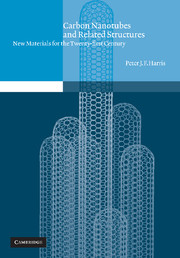Book contents
- Frontmatter
- Contents
- Acknowledgements
- 1 Introduction
- 2 Synthesis: Preparation methods, growth mechanisms and processing techniques
- 3 Structure
- 4 The physics of nanotubes
- 5 Nanocapsules and nanotest-tubes
- 6 The ultimate carbon fibre? The mechanical properties of carbon nanotubes
- 7 Curved crystals, inorganic fullerenes and nanorods
- 8 Carbon onions and spheroidal carbon
- 9 Future directions
- Name index
- Subject index
3 - Structure
Published online by Cambridge University Press: 28 January 2010
- Frontmatter
- Contents
- Acknowledgements
- 1 Introduction
- 2 Synthesis: Preparation methods, growth mechanisms and processing techniques
- 3 Structure
- 4 The physics of nanotubes
- 5 Nanocapsules and nanotest-tubes
- 6 The ultimate carbon fibre? The mechanical properties of carbon nanotubes
- 7 Curved crystals, inorganic fullerenes and nanorods
- 8 Carbon onions and spheroidal carbon
- 9 Future directions
- Name index
- Subject index
Summary
Particularly, I have urged them to learn what they can of chemistry,
for I feel that chemistry is basic structure, ergo architecture.
Buckminster Fuller, The Comprehensive ManClassifying the structures of carbon nanotubes poses an interesting challenge. Although essentially crystalline, these tubular structures cannot be treated in terms of the conventional crystallography of three-dimensional solids. Theoretical methods have been developed for analysing cylindrical arrays in biology but these are insufficient for a full analysis of nanotube structure. New methods are therefore needed. Fortunately, several groups have developed such methods, and a complete framework for analysing the structures and symmetries of cylindrical nanotubes is now available. These methods have been essential in determining the electronic and vibrational properties of nanotubes, as discussed in the next chapter. Theoretical discussions have also been given of the layer structure of multiwalled tubes, of helically coiled tubes and of other aspects of nanotube structure such as elbow connections.
Experimental studies of nanotube structure have mainly been carried out using high resolution electron microscopy, and many beautiful images revealing the intricate structure of multiwalled nanotube caps, internal compartments and so on have been published. Atomic force microscopy (AFM) and scanning tunnelling microscopy (STM) have proved more difficult to apply to nanotubes but some useful images, particularly of single-walled tubes, have been achieved recently. As a result, we now have a reasonable understanding of the main structural features of both multiwalled and single-walled nanotubes.
Information
- Type
- Chapter
- Information
- Carbon Nanotubes and Related StructuresNew Materials for the Twenty-first Century, pp. 61 - 110Publisher: Cambridge University PressPrint publication year: 1999
